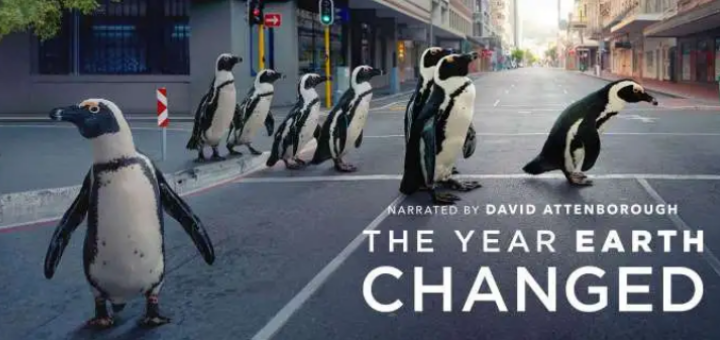
The Year Earth Changed – Highlights
This week I watched the absolutely stunning new documentary ‘The Year Earth Changed’ – launched by Apple TV+ and narrated by the one and only Sir David Attenborough. As humans all but disappeared from cities and areas across the globe due to the coronavirus pandemic, scientists and naturalists were able to monitor how this affected other species. The film begins by saying that they documented “clearer air, cleaner waters – and nature starting to flourish in ways we haven’t seen for decades.”
As Sir David put it, this was “A global experiment of epic proportions”.
Read more: The Year Earth Changed – HighlightsSome of the highlights
Global traffic noise reduced up to 70% – a lot of people noticed bird song, in even huge cities like San Francisco. Birds living in the shadow of the Golden Gate Bridge were even heard since traffic was at its lowest levels since 1950s – researchers even detected new notes in the white-crowned sparrow’s song! During the pandemic, the urban birds’ calls became higher quality, each call packed with more information than before. The lack of human noise also allowed the urban birds’ tunes to travel around twice as far.
Air pollution drops at staggering speed – Los Angeles is enjoying its best air quality for 40 years. Visibility is at the best it’s been in some people’s entire lifetime. The Himalayas even ‘appeared’ in India, next to a city of nearly 1 million people who had never seen it from their homes before. Imagine what this should look like, without smog? Or imagine living right next to this astonishing natural icon and never seeing it.
In a whole year since the first lockdown, annual global emissions of CO2 fell by 6%, the largest drop ever measured.
Sea turtles nesting successfully. In Florida, endangered sea turtles return to the beaches every 2-3 years to lay their eggs. Turtle numbers are in steep decline, and ever busier beaches and human disturbance impedes their return. But this year was different. Hundreds of loggerhead turtles came to Juno beach, laying their eggs in peace for the first time in their lives. Researchers were able to count the amount of turtle tracks, and numbers jumped from 40% to 61%.
Clearer calls for whales. The film documented ‘a new quiet beneath the waves’ in south east Alaska – 10,000 humpbacks head here to feed, but sea traffic drowns out their calls. Ships in the region carry over 1 million people a year, so researchers studied the water to see what an impact this lack of traffic was having. They found that this year was 25x quieter underwater! Scientists recorded a remarkable change, with more whales having more vocalisations between each other. They even noted that mothers left their calves alone, which is an incredibly rare sight – the mother could now go off to feed and still hear her baby.
Similar findings happened in New Zealand as global shipping dropped by 17% in the first 3 months – scientists recorded that dolphins off NZ had tripled their range of communication.
Deer remember their historic feeding grounds. Nara, Japan is one of the most fascinating areas I’ve personally visited – their sacred sika deer turn to 13 million annual visitors to get tasty rewards of rice bran crackers! (I got mugged by a few very clever deer myself, they’re adorable and have even learned to ‘bow’ to people and get more food).
When the tourists almost completely disappeared in 2020, many people were worried these deer would starve without help. What researchers saw was fascinating. Some of the older deer started to lead a group out of the temple grounds, seemingly knowing exactly where they are going. Seen walking down a major road, they headed further into the city, to the surprise of locals keeping indoors. They were seen in a small green patch of land, part of what was once a traditional feeding ground – the older deer had remembered it, and led the others through the city to find these patches! They were seen many times heading back to these patches, now mostly eclipsed by housing and buildings.
Another upside to the lack of people – this new diet made them healthier, and less plastic rubbish around helped the animals’ health.
Water quality
The river Ganges shows 80% increase in oxygen levels. Heavily polluted (stats here).
On the Atlantic coast in Morocco, water quality went from poor to excellent within the lockdown.
Wildlife in Africa
With the safari season in South Africa cancelled due to travel restrictions, one luxury lodge found new guests appeared. Vervet monkeys were seen by the pool, while impala and antelope headed in to enjoy the tasty plants. A fully grown male leopard also joined in, a usually nocturnal hunter appearing in the day to the surprise of a film crew! He then proceeded to relax on the veranda. “It’s pretty much become his private kingdom” said a cameraman. Leopards have lost over 60% of their territory to people.
African Jackass penguins in Cape Town were seen wandering through the city. This is another region I’ve had the pleasure of visiting, and back in the early internet days nobody back home believed me that I’d seen penguins in South Africa! 😀 Researchers here noted that penguins were able to feed their young properly in the day, instead of avoiding humans on busy beaches and having to feed them only at night. Being able to go out to sea 2 to 3 times a day they were seen to be feeding their chicks more, and families are successfully rearing twins and even a second clutch! People had assumed penguins got along with people here just fine, but we were actually impeding their behaviour severely. Partial beach closures and measures are being suggested to help the penguins thrive in future.
The Year Earth Changed showed effects of the pandemic even reached the Maasai Mara, Kenya. Surprisingly for a fairly remote region, dense traffic from safari-goers used to surround cheetah after a kill, which drowned out the calls of the cheetah to their young cubs, meaning they couldn’t hunt and protect their cubs. But this year, without disruption, they were seen to be able to call to their cubs who hear the mother instantly. They can’t call loudly in case they attract attention to the cubs, but couldn’t shout over the engines of safari vehicles and their people. More cubs are surviving to older ages already, which is a great sign. Only 7,000 adult cheetahs are left in Africa so they need all the help they can get.
Uganda – mountain gorillas gave birth to 2x the usual amount of babies!
And closer to home, in Dorset – rare spiny seahorses are in record numbers, as their habitat recovers from the usual heavy boat traffic. Seahorses often frequent the British coast even though most people are completely unaware, and they’re incredible creatures who are hugely vulnerable to disturbance.
How can we better coexist?
In India, some people are already living more harmoniously – in Assam, elephants (needing 150kg food a day) regularly headed into farmland, raiding crops to survive as their own habitats were continually threatened. Farmers tried to defend, but they still lost over half of their rice harvest, leading to clashes between elephants and people. Elephants were chased by large groups holding fire torches and making loud noises – sadly around 100 elephants were killed every year.
One community is trying a project by a local conservation trust, to make a plantation just for the elephants. Almost 400 acres helps feed them, and they even hold a special ceremony to welcome the elephants. As they did this, they didn’t know what the results would be. Would the elephants ignore this and eat their crops anyway? It turns out that 26 elephants and their babies quickly emerged, feasting only on the crops specially planted. As the harvest season progressed, the elephants NEVER strayed into the farmland or villagers. The villagers are happy, and other villages are talking to them to try and adopt this method. Animals rarely head into human territory unless they have to, and co-existing can help preserve their environment as well as our own.
One of the quotes that caught my attention in the documentary was “Not taking it for granted that we’re going to do the same things when we go back”. For all the horrific statistics and outcomes of the pandemic, I’d like to think that we can learn from any successes and forge a path forward. Where positive signs have been seen for nature, this is proof that we can help endangered species and habitats and reduce our impact.
As The Year Earth Changed advises, we can all make modest changes to continue the successes we’ve seen for nature: where you live, you can advocate for measures like nightly beach closures, slower boat traffic, dark sky friendly lighting, or small alterations we could make to help live alongside our fellow living beings. Remember that air, water, light and noise pollution all affect animal populations (and humans too!), sometimes in ways we can’t even see, and even small changes can help.
Find out more or watch the trailer on YouTube and let us know what you think!



